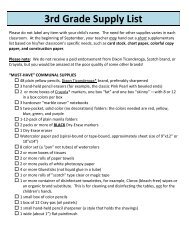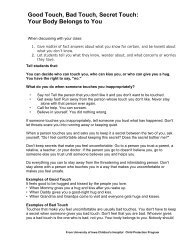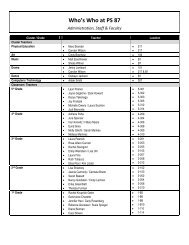Reading Behaviors Chart - Ps 87
Reading Behaviors Chart - Ps 87
Reading Behaviors Chart - Ps 87
Create successful ePaper yourself
Turn your PDF publications into a flip-book with our unique Google optimized e-Paper software.
<strong>Behaviors</strong> of Early Readers<br />
• Being aware of punctuation and using it for phrasing and meaning.<br />
• Searching visual information to figure out new words while reading.<br />
• Using the syntax of written language to predict, and then checking the accuracy of the prediction.<br />
• Analyzing new words and checking them against what makes sense or sounds right.<br />
• Controlling early strategies even on novel texts.<br />
• <strong>Reading</strong> with fluent phrasing and attention to meaning.<br />
• Moving quickly through text.<br />
• Using known words and parts of words as well as letter-sound relationships to get to new words,<br />
and checking against other information such as meaning.<br />
• Using multiple sources of information to self-correct.<br />
• Moving through text using pictures and print in an integrated way while attending to meaning.<br />
• Solving new words by using word analysis, then checking the words against meaning.<br />
• Monitoring one’s reading (accurately reading long stretches of text with intermittent hesitations and repeats.)<br />
• Self-correcting close to the point of error.<br />
• Rereading to check and search.<br />
• Discussing ideas from the story in a way that indicates understanding and discussing characters in a way<br />
that indicates understanding and interpretation.<br />
• Effectively managing a variety of texts, including fiction and informational texts.<br />
• Connecting text to other texts.<br />
• Fluent and phrased reading, especially when rereading.<br />
• Competent problem solving of new words on initial reading.<br />
• Flexibly checking one’s reading against meaning.<br />
• Using information sources (meaning, syntax, and visual information) in integrated ways while<br />
focusing on meaning.<br />
• Making connections between texts through discussion, art, or writing.<br />
• Demonstrating an understanding of and empathy with characters through discussion, art, or writing.<br />
• Moving toward easy, fluent reading even of unfamiliar and difficult texts, demonstrating less overt<br />
problem solving.<br />
• Self-correcting at the point of error with fewer returns to the beginning of sentences or phrases.<br />
• Coping with unfamiliar concepts.<br />
• Gaining momentum while moving through the text because knowledge is being constructed about<br />
how this text works and what it likely to say.<br />
• Using skills and strategies effectively on a variety of texts.<br />
• Sustaining interest and fluency through a longer text.<br />
• Easily coming back to a text if it requires more than one sitting.<br />
• Solving unfamiliar words or concepts “on the run” without detracting from meaning.<br />
• Self-correcting when necessary to support meaning but showing a general forward thrust<br />
(checking and self-correcting behaviors become less overt and more internal).<br />
• <strong>Reading</strong> silently much of the time, no longer finding it necessary to vocalize every word.<br />
• Demonstrating an understanding of the story or text through discussion, art, and writing.<br />
• Moving flexibly from nonfiction to fiction and vice versa.<br />
• Using ideas from one’s reading in one’s writing.<br />
• Summarizing or extending a given text.







